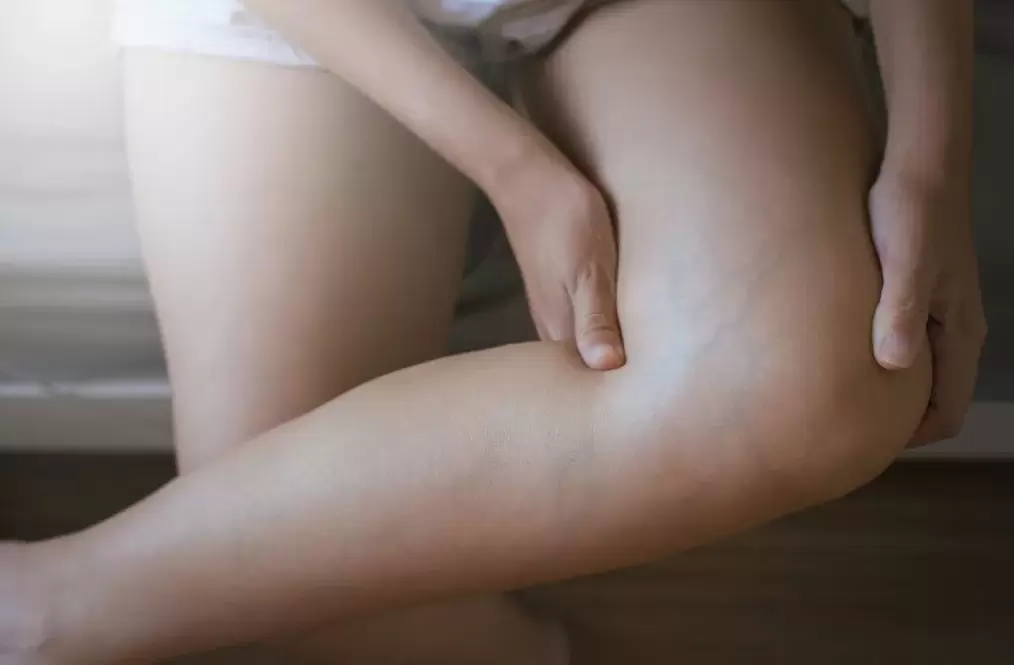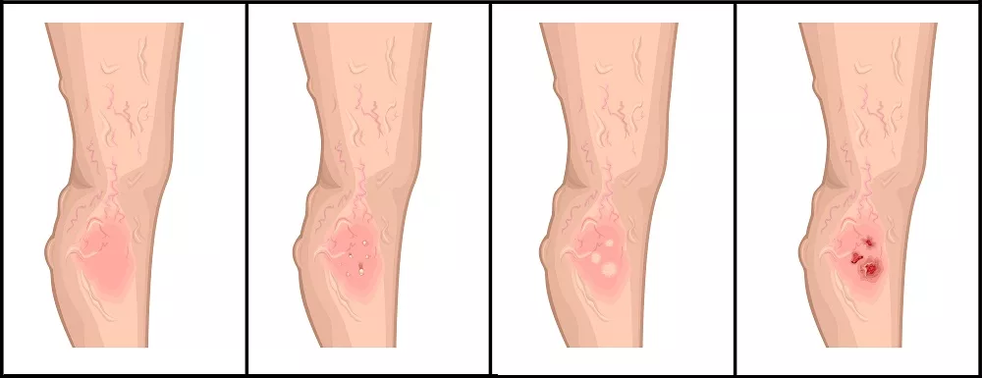
What are varicose veins and how do they manifest themselves? What happens if you do not treat varicose veins and how to prevent it? We talk about the complications of varicose veins, explain in detail why trophic ulcers appear and why compression stockings are needed.
What are varicose veins and how do they manifest themselves?
The arteries have special valves that prevent blood from flowing down the arteries. However, with varicose veins, these valves do not close completely - blood collects in the vein and stretches it.
Symptoms of varicose veins in the early stages:
- The veins in the legs become brighter and more visible;
- Varicose veins begin to appear on the inner surface of the legs and thighs;
- If you stand, sit or walk for a long time, there is a feeling of heaviness and fullness in the legs (mostly in the evening, in calves);
- Painful or sharp pain is seen in the areas of varicose veins, in the evening and at night - cramps in the calf muscles;
- The legs are very swollen by the end of the day, but the swelling disappears in the morning.
It is important!
It is necessary to consult a doctor at this stage.
As it progresses, varicose veins become chronic (chronic venous insufficiency). Symptoms:
- Strongly curved dark blue intradermal veins are visible: they protrude above the surface of the feet and legs, resembling already ripe bunches of red grapes;
- There is arched pain in the legs and calves, a feeling of warmth in the legs, nocturnal cramps in the calf muscles, severe swelling;
- The skin dries, pigmentation appears, darkens, brown spots appear.
It is important!
Do not start the disease! With varicose veins, tissue nutrition is impaired. There is not enough nutrition for the vessels and skin - sores, eczema and even sores appear, heal very poorly.
Treatment of varicose veins
There are two ways to treat varicose veins: conservative and surgical.
- Conservative: compression therapy. Compression underwear compresses the affected leg - the diameter of the superficial veins is reduced, the proper pressure in the vein is restored. Blood return is reduced, the walls of the arteries remain in good condition, the valves close, the blood does not stagnate and circulates well, and the speed of blood flow in the deep veins increases. Stagnant blood volume decreases, lymph flow improves.
- In advanced cases, when conservative treatment does not help, the doctor will suggest surgery: varicose veins are removed, the affected veins are removed. Shutters are placed to restore function, or the valve's mobility is restored so that its leaflets close.
Compression stockings for varicose veins and ulcers
Compression stockings are special socks that sit firmly on the lower leg and loosen further as you rise to the thigh. It improves blood circulation and stimulates blood flow to the heart from the lower extremities.
Compression stockings are selected individually, so first consult a phlebologist: you can not choose socks yourself.
The phlebologist will look at the tone of the vein, which special valve has a problem with the valves not closing. The problem may be, for example, the Buddha: then you need to wear compression stockings. If there is a problem closing the valve below the knee, then socks or stockings are chosen.
It is important!
Compression stockings should always be worn for maximum effectiveness - only removed before bedtime.
How to wear compression stockings?
- After waking up, put your feet on the wall and lie down for a while - let the blood flow to the hips as much as possible;
- Wear compression stockings without getting up.
In this position (sleeping, legs raised) blood flow is equal, the blood does not stagnate. When compression stockings are on the feet, the arteries are in good condition and the valves close well and push the blood further out of the arteries.
What happens if varicose veins are not treated?
If you do not start treatment for varicose veins on time, life-threatening complications can occur:
Thrombophlebitis- Inflammation of the veins due to the formation of blood clots in the veins. Symptoms:
- redness;
- the site of the thrombus becomes hot;
- An inflamed vein hurts a lot.
If you start treatment on time, it will stop the growth of thrombi. Residual blood clots can be resolved over a long period of time - sometimes months. If left untreated or misdiagnosed, clotting can increase.
Pulmonary embolism.The thrombus that forms with thrombophlebitis separates from the vessel wall in the leg and is separated by blood flow. Closes the pulmonary artery or branches - it is fatal. Unfortunately, even if they suspect this complication in time, doctors can not do anything about it.
Symptoms:
- chest pain;
- accelerated heartbeat;
- shortness of breath;
- unfounded anxiety and unfounded fear.
Deep vein thrombosis of the lower extremities. This is a serious and dangerous complication of varicose veins. The internal arteries are blocked, so blood flow is almost completely stopped - not all the tissues of the foot are nourished and turn blue.
Venous gangrene of the extremities- malnutrition, severe deep vein thrombosis with impaired arterial blood flow. Gangrene is caused by a lack of blood flow: the foot actually dies - starting with the toes.
Trophic ulcers- long-term incurable ulcers caused by malnutrition of tissues. Lymph stagnates in the lymphatic vessels, they carry a large load and can not cope with the amount of lymph. Therefore, lymph drops begin to differentiate through the skin. Therefore, the epidermis begins to erode - an ulcer with torn tight edges. Any touch to it causes severe pain.
Bacteria grow rapidly in ulcers: the infection merges, the bleeding wound begins to purulent. This can lead to very serious complications, including blood poisoning.

There are two types of trophic ulcers:
- when venous, subcutaneous and deep veins of the surrounding area are affected;
- arterial, when the arteries of the foot are affected and the natural nutrition of the limbs is impaired.
Treatment of trophic ulcers
Trophic ulcers are treated with elastic compression, medication, physiotherapy and surgery.
Trophic ulcer care consists of four stages.
The first stage - antiseptics
- Antiseptic solution for wound healing. It is applied to the surface of the trophic ulcer, if there are gaps under the skin, they are also filled with gel.
- The gel, which has antimicrobial and anti-inflammatory effects, improves microcirculation, reduces redness and swelling of the skin, reduces pain, eliminates itching and peeling of the skin, prevents the spread of infection and scars.
- Aqueous solution of halogen group or benzyldimethyl-myristoylamino-propylammonium antiseptic.
The second stage - gels to soften dead tissue
Dead tissue is necrosis: black hardened tissue on the surface of the ulcer. If not removed, the ulcer will not heal. To do this, first of all, the necrosis is softened. This is done using special gels.
The third stage is the formation of an optimal environment for wound healing
Healing is facilitated by creating a moist environment. If there is no necrosis, use bandages to heal quickly. Here are some bandages that will fit:
Alginate dressings:
- Alginate dressing, which turns into a soft gel when in contact with wound secretions, providing optimal conditions for the healing of moist wounds;
- A dressing that fills the wound cavity and creates a microenvironment that promotes rapid healing;
- Sponge bandage with a layer of hydrogel. Its structure absorbs secretions and maintains a moist environment;
- Alginate sponge dressing consisting of calcium alginate and hydrocolloid;
- A self-absorbing sterile coating based on sodium alginate, which is well-suited for wounds and burns, accelerates healing;
- Hydroactive dressing for deep wounds. Cleanses the wound, accelerates healing, maintains the optimal environment for up to three days without changing the bandage.
Sponge bandages:
- Double-sided foam bandage. Protects the wound, absorbs wound discharge, creates optimal water balance in the wound;
- hydrophilic polyurethane sponge dressing;
- A dressing with enzymes and chitosan complex is suitable for infected wounds (if there is pus in the wound);
- Antimicrobial sponge breathable dressing made of polyurethane sponge layer and silver alginate matrix.
The fourth stage - wound healing
After the wound is cleaned and an optimal environment is formed there, it begins to heal, and the edges of the wound become smaller. Use special dressings for safe and fast healing.
Mesh ointment dressings:
- Ointment bandage with Peruvian balm to be applied when fresh skin appears;
- Ointment based on triglycerides, which promotes wound healing and cares for the edges of the wound;
- The wax square-like bandage is soft and fairly tight. Can create up to seven days;
Film bandages that can be used to bandage wounds:
- The film (but breathable) water-repellent bandage protects the wound from microorganisms. Can be used to correct previous dressings and as an independent dressing.
- Transparent film polyurethane bandage, the skin under it does not sweat, breathes.
It is important!
These dressings are suitable not only for trophic ulcers, but also for any wounds that heal for a long time.
Prevention of varicose veins
- Move as much as possible: the more you move, the better the blood circulates in the arteries;
- Give up bad habits;
- Contact a phlebologist in a timely manner at the first signs of illness;
- Periodically perform vascular ultrasound - the doctor will see the first changes;
- Come home after work one day and lie on the wall with your feet for about 15 minutes.
Prevention of trophic ulcers
- Pay attention to your weight: it puts pressure on your feet, loads the vascular and lymphatic systems. If necessary, follow a diet;
- Walk as often as possible;
- If possible, lift your legs and keep them in a high position as often as possible. In the evening, you can lie on the couch and lift your legs against the wall: you need to sleep for at least 15 minutes;
- Treat the vessels of the lower extremities in a timely manner;
- Quit smoking - it significantly reduces the blood supply to the tissues and promotes the development of trophic ulcers;
- Take care of your feet: wear appropriate shoes so that they do not sting or rub;
- Check your feet regularly: check the color of the skin on your feet. In the evening, if the feet become blue and veins appear in the feet, contact a phlebologist;
- Moisturize skin with emollients, moisturizers, nourishing creams;
- Keep your feet warm, dress appropriately for the weather;
- Try not to damage the skin.


















